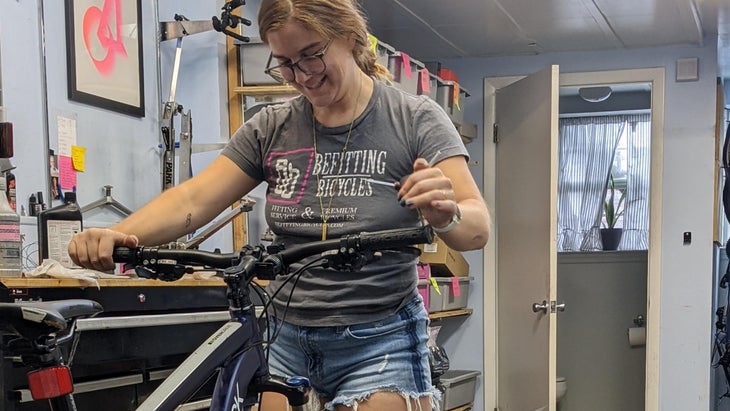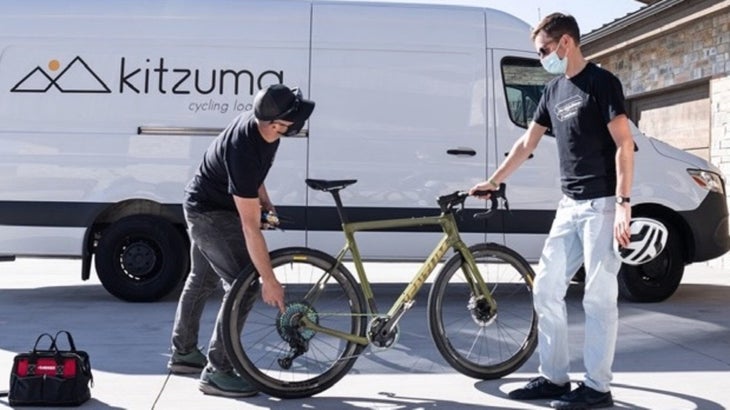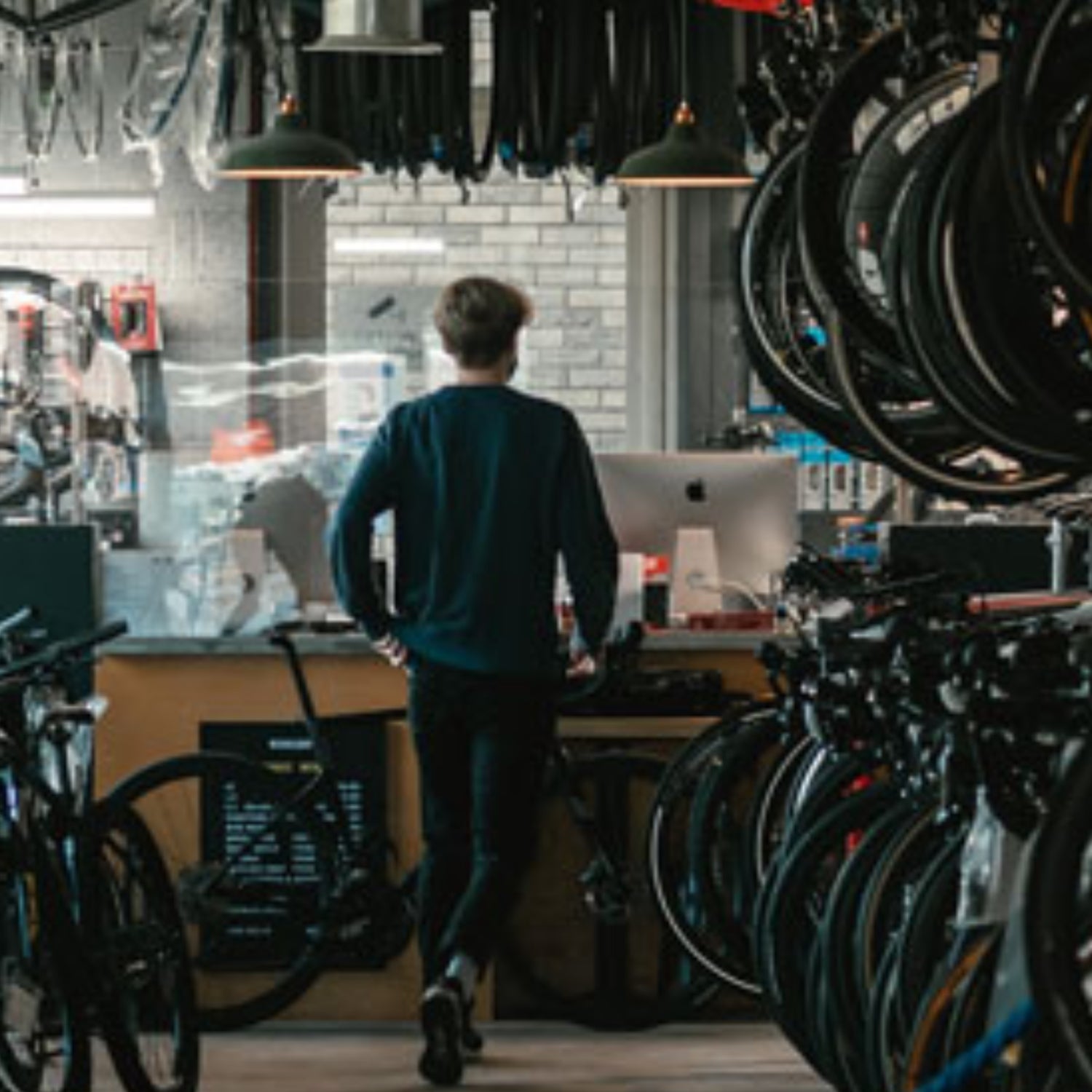The fall of 2022 was supposed to be a chance for bike retailers to catch their breath after two crazy years.
A month after lockdowns had them wondering about their future in the spring of 2020, they suddenly couldn’t keep up with demand. For a year and a half, staff worked overtime as Americans rolled out their dusty steads or bought new ones. A 50 percent increase in riding, plus supply chain snafus and factory lockdowns dwindled inventories. Then, just as supply and demand evened out last fall, a new challenge walked into stores dressed like a delivery person: a glut of bikes and parts arrived during the darkest days of the year.
“We’ve been waiting for this inventory for a year or more,” says Nick, the owner of two Utah bike shops, who asked that we not use his real name because he didn’t want to alienate his sales reps and dealers. “And we’re getting it all at once and at the worst possible time. No one is buying bikes or getting their bike serviced in the fall and winter.”
His shops received so much inventory that Nick ran out of space and had to rent 10 storage units.
“Worse than excess inventory is that it’s not the right mix of inventory,” he says. “We have too much of this, too little of some things, and did we even order that?”
When his main supplier launched a new gravel bike with a major marketing campaign, Nick didn’t have a single model in stock.
“We’re supposed to be a launch partner, but they had no bikes for stores at the same time they had every color and size available on their website,” he says.
But he can’t complain. “During the inventory shortage all the manufacturers gained a lot of power,” he says. “They decided who got inventory.” Now, he worries if he rocks the boat he’ll lose even more access to the bikes or get dropped as a dealer. That’s why we agreed not to use his real name.
It’s all costing Nick money—in storage fees, staff time and debt financing. And things may only get worse. All of the dozen people we talked to for this article say Nick’s situation is the norm. With bills piling up, bike retailers will start discounting what they can. Nick will have to match prices. With demand slowing—he says it’s already 10 percent lower than last year—he expects spring 2023 inventory to arrive long before he has sold most of the just-arrived 2022 models, which will lead to more storage issues, more discounts, slimmer margins. The vicious cycle could spin out of control. “It’s going to get more difficult before it gets better to the point some dealers are not going to make it,” he predicts.
But smart and creative independent bike shop owners are finding ways to work with the inventory challenges by doubling down on service, embracing the new pandemic cyclist, and finding ways to reach novel customers near and far. Despite a busting bike market, inflationary woes, and increased competition from their suppliers and the used market, these shops are optimistic about the future.
Bull whips and snake bellies
The pandemic-fueled inventory roller coaster is not news to any outdoor related retailer. Even other specialty niches like paddling shops are facing challenges with out-of-season inventory piling up, too much of this, and not enough of that. But in many ways the bike industry suffered more during the last three years than other verticals and thus its woes are more extreme, says John Williams, the former president of Live to Play Sports, the owner of Norco Bikes and the distributor of .
First, manufacturing is more concentrated. For instance, just a handful of factories in Taiwan and China produce most of the premium bike frames worldwide. The bike supply chain is also more complex. Even budget friendly bikes include dozens of parts. One unavailable component stalls delivery of the whole bike. And during the pandemic, bike riding boomed more than most outdoor activities. The U.S. Census department says participation increased by 50 percent in New York City. Nationwide bike industry sales jumped nearly 50 percent in 2020 and 2021, , according to NPD Group, a business research company.
The result is what’s known as a bull whip effect. As retailers saw demand for bikes surge, they ordered, say, 25 percent more inventory than normal. When the inventory didn’t arrive in time, they ordered the same amount from someone else and started hoarding what parts they did have. Distributors took that 50 percent order and added their own 10 percent bump. Brands did the same, asking factories to make 70 percent above what they would normally need. Two years later the whip is finally snapping. Missing parts arrived, factories caught up with back orders, cargo ships sailed, port strikes ended. Now all the inventory is arriving in warehouses and shops, at the same time that consumer demand is falling, recession and inflation talk is locking up wallets, and the used bike market, particularly online, is overflowing.
“It’s like the belly of a snake after a big meal,” Williams says. “It’s going to take time for the inventory bulge to move its way through the system.”
Some brands are helping retailers digest. , a Canadian company, has extended its payment terms to give shops more time to sell the bikes it just delivered. Some brands are allowing dealers to rewrite orders, says Williams, something they normally wouldn’t do. And SRAM, a components maker that rarely allows deviation from its minimum advertised price guidelines, gave shops permission to put 200 SKUs on sale.
“Our goal is to create demand so that our retailers, partners, and we at SRAM are in the best position regarding inventory going into next spring season,” said
To Williams, that shows retailers are in a power position. “All the product has to make its way through the supply chain and the majority of it will still sell at retail,” he says. But that doesn’t mean the next year or so won’t be tough for bike shops. Williams says it’s time to be creative, reimagine the in-store experience and offer something not available online.
It’s not all about sales
is a good example of what that could look like. There is almost no inventory at all in the Philadelphia, Pennsylvania store. And that’s exactly how Isaac Denham wants it.

“I managed a traditional bike store and watched $250,000 worth of inventory collect dust,” says Denham, who opened Befitting in 2018 with store manager Victoria Edwards. “I wanted to do everything in my power to keep our inventory dollars low.”
In fact, the duo prefers to call the store a fitting studio, not a bike shop. Instead of rows of bikes and walls of helmets, there’s a fit bike, which they can adjust to mimic everything from an extra small mountain bike to an extra large triathlon bike. Before the pandemic customers would come in for a fit appointment and then Denham or Edwards would order the bike and parts. With multiple distributors within a few hours of their shop, they would have everything the next day to build the custom bike and deliver it to the client within a week.
In the summer of 2020, once they could restart fit appointments, the landscape shifted during the 2020 lockdown and bike boom. Delivery was no longer an option and they couldn’t beat direct-to-consumer online prices. Rather than fight it, they went with the flow. Now after the fit appointment, they tell the clients what to order online. When the parts arrive, Edwards and Denham build the bike.
What seemed like a loss was actually good business. For a 90-minute bike fit appointment Befitting charges $300. An average $1,000 bike might put $250 in a store’s register, but that’s before subtracting the cost of shipping, storage, credit card fees and shop time to build and sell the bike.
“A bike sale looks good on paper, but bike fit is more profitable,” says Denham.
And it creates more loyalty, adds Edwards. “My fit clients are telling me stuff about their body they have never told anyone else,” she says. “That intimacy builds trust and creates clients, not customers. The difference in relationship is big.” Edwards says he has many “clients” who drive an hour to have their bikes serviced at Befitting.
Embrace the new riders
Obviously not every bike shop can focus on a luxury service like fit. But everyone can focus on building a community and Patrick Hogan, the senior research manager for the , thinks there is an untapped market of consumers looking for a welcome sign.
In late 2020, PeopleForBikes, which represents 320 bike-related suppliers, commissioned . Of the 2,803 respondents, a quarter got back on a bike for the first time in a year or more during the pandemic. The eight percent who were brand new riders were more likely to be women and minorities.
“The lesson, I think, is there is a lot of opportunity to grow the sport with audiences not typically targeted with marketing and communications,” Hogan says.
When the study asked what it would take to keep them riding, Hogan says the top two responses were infrastructure and community. Advocating for bike lanes is a logical move for some bike shops, he thinks, but it’s a long play. Finding ways to welcome new riders into the sport is a shorter term lever that any retailer can pull.
“If you engage them in the sport, they’re probably going to purchase more product,” says Hogan.
Befitting used to have beer and pizza night every Friday. But like group riders, movie nights, event sponsorship and other classic forms of community engagement, the party nights died during the pandemic and are slow to reemerge.
There are simpler options. Right from the beginning of the pandemic, bike shop in Cleveland, Ohio, concentrated on one thing: getting people on bikes, quickly. Instead of the five week service waits at most shops, staff worked overtime to keep turn-around time to three weeks or less, says manager Antoine Powell.
“Putting your nose to the grindstone makes a good lasting impression,” he says. “I think we got a lot of new faces in here with word of mouth about our service time.”
When they noticed new riders balking at the price of a bike, particularly e-bikes, they introduced financing. Offered through a third party, the retailer eats the interest on the payment plan. But it helps close sales, ensures customers don’t buy an inferior product, which might turn them off cycling, and gets them riding right away, rather than later with a layaway plan, says Powell. Customers are pleasantly surprised by the option.
“More people riding good bikes, means more people enjoying riding, which expands the bike culture,” he says. “We’ll benefit later.”
Every shop is national
Both service and engagement rely on the inherent challenge of selling bikes online: They are too complicated for most people to build and tune out of the box. It’s why traditionally bike shops have had very local markets. But locked stores and contactless services changed the behavior of cyclists just as much as any shopper. Tapping into this shift presents opportunities for retailers, says Cameron Simpson, the head of North America for BikeExchange, an online marketplace where hundreds of bike shops sell their inventory.
“Our retail spaces are becoming antiquated. But the people that are riding bikes stay youthful,” she says. “We need to keep up with the demographic.”
Part of Simpson’s role is engaging with the individual shops that partner with BikeExchange. To manage their inventory challenges some are tapping into niche markets, like working with hotels or cruise ships to supply rental fleets for their guests. Others, like Dallas, Texas-based Playtri, are buying shops and franchising to use economies of scale, like for balancing inventory between stores. But the most productive strategy is to expand online to find new customers beyond the neighborhood, says Simpson.
About 20 percent of all retail sales happens online, according to the U.S. Census department. The number for the bike industry is much lower, says Simpson, but it’s growing. Sales on Bike Exchange’s marketplace increased by 120 percent between 2019 and 2020 and another 60 percent in 2021. 2022 was flat, but conversion rates increased, says Simpson. More telling, the number of BikeExchange retail partners has increased from 130 nationwide in 2020 to more than 200 today, as more and more shops look for ways to move overstocked inventory, Simpson says.
Even on a more local level online is powerful, says Tuvi Mrakpor, a sales associate at Sweet Pete’s Bike Shop, a business with two locations in Toronto, Ontario.
For most of 2020 customers weren’t allowed in stores in Ontario. Sweet Pete’s had to pivot to digital and virtual. Now, even though there are no restrictions, they continue to conduct significant business online, he says. It’s not just customers in Toronto either. They’re selling bikes into other markets where customers can’t find the specific model they want locally.
“The store is functionally a warehouse,” says Mrakpor.

The challenge is delivering the bikes. For out of town customers, Sweet Pete’s builds the bikes up like they would with an in person sale, carefully rebox it, and pay to ship the bike with Canada Post or a courier company. That still requires the customer to put the bike back together. Simpson says other stores bought vans and bike trailers so they could deliver ready-to-ride bikes. And BikeExchange saw this as an opportunity and started an offshoot business, Kitzuma Cycling Logistics, that specializes in delivering fully assembled bikes from shops to customers across the country.
“The industry has flat out tried to avoid online,” says Simpson. “They can no longer put off that this is where consumers want to shop.”
Bike service online?
The advice seems to pull retailers in two directions. Service and engagement is all about offering something that’s unavailable online. But it also points to a potential future where the bike shop is more of a showroom. With bikes still dominating most retailers’ sales and revenue stats, according to the National Bicycle Dealers Association, that’s a hard move to make.
John Williams has some simpler advice for retailers: Look for ways to embrace new customers and don’t panic. There will be chaos. There will be disruption. But when the snake stops looking like a beach ball there will still be bicycle retailers.
“People have been calling for the death of the independent bike dealer for 30 years,” Williams says. “But they are the fabric and soul of the industry. Brands need them. Consumers need them.”
And that won’t change until someone figures out how to tune gears or change a tire online.


